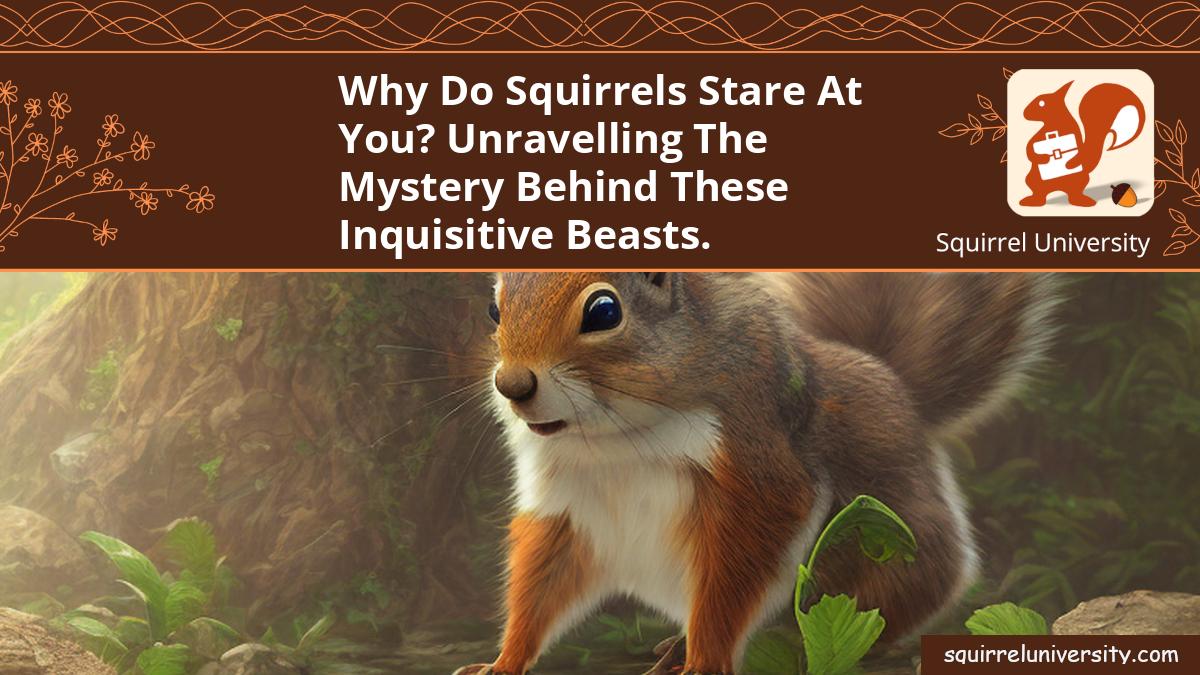Squirrels have a natural curiosity and when they detect no danger, it’s not uncommon for them to take a closer look at something new by staring intently. They seem to have a fascination with the unfamiliar and love investigating their surroundings.
Squirrels are naturally curious mammals and often stare at potential sources of food, such as people. They may also observe something out of the ordinary, or new to their territory, with intense interest. In addition, squirrels may stare at a person if its survival instincts detect no threat from them. As long as a person remains still and does not startle the animal, it may continue to observe the person out of curiosity.
Why Do Squirrels Stare At You?
It’s not unheard of for humans to be stared at by squirrels, especially when out and about in nature. But why do these inquisitive creatures give us such close scrutiny? While it can be strange or even off-putting, their curiosity is often driven by instinct.
Squirrels are naturally curious mammals and often stare at potential sources of food, such as people. They may also observe something out of the ordinary, or new to their territory, with intense interest. In addition, squirrels may stare at a person if its survival instincts detect no threat from them. As long as a person remains still and does not startle the animal, it may continue to observe the person out of curiosity.
The Science Behind A Staring Squirrel
Establishing if You are a Threat
Squirrels possess sharp senses which enable them to quickly assess any potential threats. When they observe something that does not fit into their usual routine, they will use these qualities to examine the unfamiliar object further.
A squirrel’s retinas contain two types of light receptors – rods and cones – which allows them to see both in daylight and dimmer conditions. Additionally, their peripheral vision enables them to spot any movement from a distance.
Curious About Your Behavior
A human presence may attract the attention of certain squirrels. If they determine that you don’t appear to be a danger, then they may become interested in observing your behavior up-close.
Seeking Food
A squirrel might have their eyes trained right on you, wondering what you are up to. Could it be that they’ve noticed something tasty and they’re curious if there’s a chance of getting it? Or perhaps they sense danger and want to make certain you don’t pose a risk? Whatever the case, it’s clear that the squirrel is paying attention to you, keenly evaluating the situation.
Reading Squirrel Body Language
Staring and Standing Still
When a squirrel stares while standing completely still this typically means that it is completely focused on something else – most likely an activity that it has already been engaged in prior to spotting you.
It could be investigating fallen fruit or assessing its surroundings for safety before making a move but either way its laser focus should give you an idea as to why it is staring at you intently like this.
Staring and Moving Back and Forth
The squirrel seemed intently curious, its eyes shifting between inspecting you and carrying out its own tasks. It was making an effort to comprehend what exactly it was you were up to.
By shifting its body weight intermittently between one paw and the other the animal shows that there is something interesting going on that must require further observation. p 〉
Chattering Teeth and Staring
Have you ever had a squirrel stare at you for what feels like an eternity? Chattering teeth and intense staring are common signs that a squirrel is feeling stressed or threatened. This type of behavior is known as defensive posturing, which serves to protect the animal from harm. Understanding why squirrels exhibit this behavior can help reduce stress for both the animal and humans.
Staring and Being on Hind Legs
When a squirrel stares and stands up on its hind legs, the behavior is often referred to as ‘begging’. This posture is an expression of curiosity or fear, showing that the squirrel wants to better detect potential threats. If it senses danger, this posture also allows it to make a quick escape if needed. However, it may also be begging for food from you—if you offer them food, this can teach them to beg for food from people in general. To prevent this behavior, don’t offer food or rewards to the squirrels.
In Native American tradition, the squirrel spirit animal represents gathering and preparation for the future. Through body language, they communicate their intuition of what’s going to happen in the future—it may come in shape of caution when they suspect a threat or anticipation when they sense an opportunity.
Wagging Tail and Staring
A wagging tail can indicate several different things when accompanied by staring in a squirrel. The intensity of the tail-wag and the direction will tell you how scared or excited the squirrel is. A low intensity tail-wag usually considers excitement or anticipation and high intensity tails indicates fear or suspicion of potential danger.
A squirrel may be cautiously assessing an individual if it stands there, its tail twitching rapidly, eyes intently fixed on the onlooker. Its heightened state of alertness suggests that the animal is on guard and needs more information before making a judgment about whether or not the person poses a risk.
Making Weird Noises While Staring
Squirrels might also make weird noises while staring at something new. They do this because they want to further explore the thing that has caught their attention—this includes both natural objects and humans. They chatter with their teeth to communicate their curiosity about what could possibly be out there.
The sound also serves as a warning sign for other animals in their territory that something strange is around. Therefore, making strange noises while looking at something could show territorial behavior or simply curiosity about something strange.
The Role of Hunger
Hunger plays an important role when it comes to why do squirrels stare. It makes sense for these small mammals who rely on nuts and acorns as sources of nourishment—any food source presents itself as a potential threat if not handled carefully. As such, these animals need ample time to properly observe any situation before deciding whether they’re safe enough.
If you are around birds offering seed delicacies during winter months, then these furry critters may just appear out of nowhere after getting wind of the news! Generally speaking, hungry squirrels will pay close attention to anything edible in sight – paying special attention to human hands that seem harmless yet potentially dangerous.
What The Staring Really Means
Verifying if The Squirrel is Staring or Napping
Sometimes it’s hard to distinguish between whether a squirrel is actually staring at you or napping with its eyes open—your safety depends on being able to tell which one it is doing. Looking closely at its head posture can help tell which one it is: if the head is upright then it’s probably staring intently but if it’s at an angle then it’s likely asleep.
Sniffing from time-to-time can also let you know which one it is: if they take three deep breaths then they are probably asleep while shallow sniffles signal active observation. Additionally, holding your breath often surprises sleeping animals but not those that are kept alert through attentive gazing.
Prevent Excessive Staring
Staring at humans is a normal behavior for squirrels, but excessive staring can be alarming and concerning. To prevent this, it is important to ensure that areas where squirrels live are clean and free of food sources. Additionally, providing enough hiding spots for them will allow them to feel safe and secure. Lastly, respecting the space of a squirrel and avoiding trying to interact with them will help keep them from excessively staring.
Building Trust With A Squirrel
Building trust with a squirrel can be a rewarding experience. Start by observing the animal from a distance to show them that you mean no harm. Speak softly and move slowly while you’re around the squirrel, avoid sudden movements or loud noises. You may also offer it nuts, fruits or other foods they enjoy, although these should be given sparingly. With patience and gentle manners, you can eventually gain the trust of these mischievous creatures.
Symbolism of a Starring Squirrel in Different Cultures
Squirrels have long held a significant place in many cultures. In Native American tradition, the squirrel spirit animal is seen as a symbol of gathering and preparation for the future. In other cultures, staring or wise squirrels are often seen as reminders to stay alert or to prepare for coming events. No matter the culture, many associate the inquisitive stare of these furry critters with insight and intelligence.
Squirrels in Native American Tradition
Squirrels carry a plethora of meaning to many Native American cultures. Representing the bridge between worlds, they serve as the signifier of entering life’s transitional periods like youth, and of the ability to make one’s own way in life. As a symbol, the squirrel serves to remind us that it takes effort to succeed in life; we must gather and store up for times ahead.
FAQ
What are the consequences of being touched by a squirrel?
If a squirrel touches you, there is only a small chance of rabies transmission. However, it is still possible to contract other diseases such as tularemia from squirrels. Therefore, it is important to always wash your hands after coming into contact with any wild animals and seek medical attention if any symptoms develop.
It’s also important to note that small rodents and lagomorphs like squirrels rarely transmit rabies and can’t pass it on to humans, so the risk of rabies in these cases is very low.
Is it possible to contract rabies from contact with a squirrel?
The risk of getting rabies from a squirrel is extremely low. Small rodents, such as squirrels, are highly unlikely to be infected by the virus and have never been known to transmit it to humans. Therefore, if a squirrel were to touch you, it is unlikely that you would contract the rabies virus.
What does it mean when a squirrel produces a crying noise?
When a squirrel makes a crying sound, it may indicate distress. This vocalization can be used to alert others of danger, or to signal that the individual is feeling threatened. They may also make this sound when they are trying to find food or shelter. Generally, it is best to be cautious when approaching a distressed squirrel and give them space.
Conclusion
Squirrels are truly curious, intelligent creatures who fascinate all of us. We’ve uncovered a few reasons why these inquisitive mammals may stare at us – to detect potential sources of food, or something out of the ordinary, or if their survival instincts detect no immediate threat. Whenever you find yourself pondering “why do squirrels stare at me?” now you know that it’s more than just curiosity.
It is clear that squirrels have much more complex behaviors and motivations than we previously expected. They truly do have the power to capture our hearts and imaginations with their innate charm and mystery, so be sure to take the time to observe them next time you come across one.
You may also be interested in reading:



